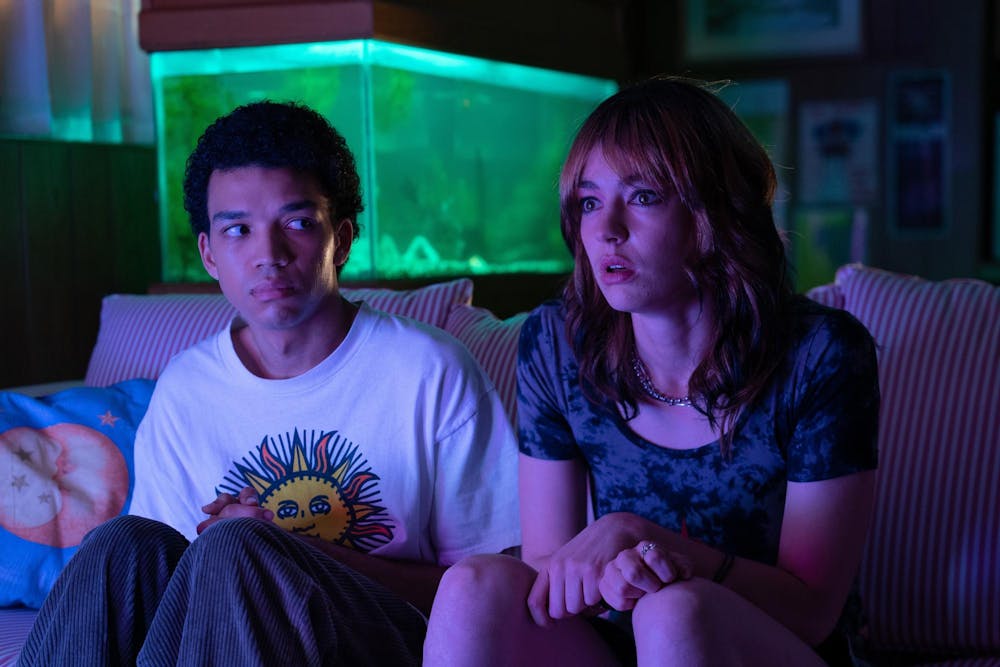About halfway through “I Saw the TV Glow,” the setting in a scene changes from a grocery store parking lot to a gay bar. Director Jane Schoenbrun introduces this new location by inserting a diegetic performance by Phoebe Bridgers and Sloppy Jane. But, for the audience viewing the film, this segment essentially functions as a music video, and it seems to be a jarring, unconventional choice for any film to make as it deliberately breaks the story’s flow.
But it works. And it works because nothing about “I Saw the TV Glow” is conventional. It exists within a long tradition of queer films that push boundaries and experiment with how a movie can look and make one feel. By positioning itself as a horror film, “I Saw the TV Glow” can take advantage of this tradition by being as unapologetically weird as it desires to be. "Lynchian” is a word that gets thrown around a lot, but it actually feels appropriate here. Like much of the work of writer and director David Lynch, the film doesn’t follow a standard story structure, it doesn’t explain anything that begs to be explained and it certainly uses odd, even discomfiting, images that stick with the viewer long after they leave the theater.
These qualities are not unique, per se, to queer cinema, but it would be entirely fair to argue that queer film often portrays the transgressive and abject. It makes sense that, having historically been treated as an ultimate Other, queer filmmakers — like Schoenbrun, who began writing the script for their film three months after they started undergoing hormone replacement therapy — would push back against the typically “straight” way of making a film. There’s often conscious inspiration from works that have traditionally been ignored by the critical establishment or deemed “low culture:” John Waters would watch exploitation flicks at his local drive-in; Schoenbrun looked toward “Buffy the Vampire Slayer” and Nickelodeon’s “The Adventures of Pete & Pete.”
The queerness of “I Saw the TV Glow” has been well documented — even if you haven’t seen the film (and there’s a good chance you haven’t: it’s been out for over a month and never distributed to Bloomington, meaning I had to drive to Kan-Kan Cinema in Indianapolis to watch it). It’s not a spoiler to note it’s an allegory for the experience of being transgender.
It’s not entirely clear whether Owen (Justice Smith), the film’s main character, could be regarded as trans within the canon of the film itself, but, for the sake of critical evaluation, we can consider him as representing the archetype of the “egg.” An “egg” is someone who is trans but has yet to realize it; in this way, “I Saw the TV Glow” becomes not merely an allegory for the trans experience but an allegory for that specific moment when the egg cracks and realizes their identity doesn’t correspond to the gender they’ve been assigned.
It’s here where most of the horror of “I Saw the TV Glow” stems, but do not go into this film expecting a traditional horror feature with traditional horror scares. It’s a psychological horror above all, and the terror exists with the assumption that you’re aware of what the work is allegorizing. And it requires that you are capable, that you are willing, to be empathetic toward the subject matter. Don’t get me wrong, this isn’t a knock on it at all: The dread continuously present in “I Saw the TV Glow” is a purely existential one that is terrifying precisely because it’s a real, shared experience that has been lived, and continues to be lived, by an entire community of people.
This is where “The Pink Opaque” — Owen’s favorite television show that may or may not cause a physical and psychological effect on the viewer — comes in. There’s an argument to be made that the program represents an idealized world for our main character, one where his inner identity matches the one he presents outwardly. But, for me, there are also clear parallels to David Cronenberg’s “Videodrome,” which follows the CEO of a television station who, after stumbling on a series of snuff films, experiences ever more realistic hallucinations. Cronenberg is known for being perhaps the most famous name in the body horror subgenre, which seems proper here: after all, isn’t the egg’s experience quite literally itself a form of body horror?
And just how directors like Cronenberg and David Lynch each exhibit an obvious personal style, Schoenbrun puts a twist on the format by invoking their own flourishes: Owen, at several crucial points, breaks the fourth wall and narrates to the audience; his best friend Maddy’s (Brigette Lundy-Paine) handwriting will often appear on-screen to indicate a new chapter or commentate on what’s happening; the lighting is knowingly unrealistic and uses color to great symbolic effect. Schoenbrun, like all great directors, is aware of the fact their film is an amalgamation of influence from other artists; it isn’t important whether “I Saw the TV Glow” is wholly original — as I mentioned before, the film exists within a much longer tradition, positions itself as such and takes full advantage of its own unoriginality.
“I Saw the TV Glow” was originally widely released in May, meaning it’s only becoming more difficult to catch it in theaters. Living Room Theaters in Indianapolis is showing it through July 3, and The Back Door here in Bloomington will be hosting a 21+ showing of it July 11. But do not let this fact deter you from seeing it: It’s already been released to video-on-demand and will, certainly, receive a proper streaming release to Max sometime this year. I urge you, if possible, to support this movie, because not only is “I Saw the TV Glow” an important addition to the queer film canon, it’s a wonderful, beautifully melancholic work in its own right.






